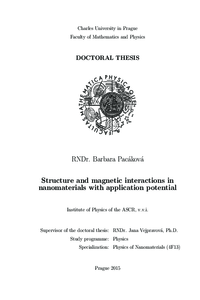Structure and magnetic interactions in nanomaterials with application potential
Struktura a magnetické interakce v nanomateriálech s aplikačním potenciálem
dizertační práce (OBHÁJENO)

Zobrazit/
Trvalý odkaz
http://hdl.handle.net/20.500.11956/65507Identifikátory
SIS: 85264
Katalog UK: 990020286690106986
Kolekce
- Kvalifikační práce [11972]
Autor
Vedoucí práce
Oponent práce
Jirásková, Yvona
Svoboda, Pavel
Fakulta / součást
Matematicko-fyzikální fakulta
Obor
Fyzika nanostruktur
Katedra / ústav / klinika (externí)
Informace není k dispozici
Datum obhajoby
29. 6. 2015
Nakladatel
Univerzita Karlova, Matematicko-fyzikální fakultaJazyk
Angličtina
Známka
Prospěl/a
Klíčová slova (česky)
nanomateriály, magnetismus, difrakce, AFM, MFMKlíčová slova (anglicky)
nanomaterials, magnetism, diffraction, AFM, MFMDisertační práce je zaměřena na fyziku magnetických nanočástic, zabývá se prob- lematikou řešení magnetických struktur, vnitřního uspořádání částice a vlivu mezičásticových interakcí a struktury částic na magnetickou odezvu nanočásticových systémů. Práce rovněž okrajově řeší makroskopické uspořádání nanočástic a jejich vliv na usporádané nanočásticové systémy. Práce přináší několik unikátních výsledků a řešení, jako například popis magnetické struktury ε-Fe2O3, metodiku pro detekci a analýzu zbytkového magnetického katalyzátoru v uhlíkovch nanotubách a rovněž řeší roli upořádání nanočástic na vlastnosti grafenu transferovaného na substrátech dekorovaných nanočásticemi. 1
The thesis is focused on the physics of magnetic nanoparticles (NPs), starting from the solution of magnetic structure, internal alignment within the single particle and role of interactions and particle structure in magnetic response of systems of the NPs. Moreover, the macroscopic arrangement of the NPs and its effect on the properties of system containing the NPs are discussed. The work brings several new results and concepts, such as the solution of magnetic structure of the ε-Fe2O3 phase, methods of proper detection and description of magnetic metal catalyst in carbon nanotubes and role of the NP arrangement and their effect on graphene placed on the top of substrates decorated with the NPs. 1
